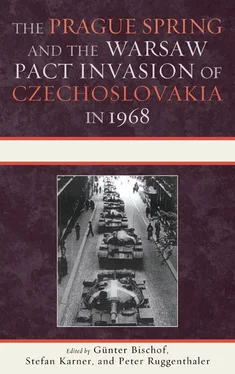The confusion, inaction, and blunders by the Soviet authorities were, in part, the result of inexperience, but they also stemmed from Khrushchev’s convictions and overconfidence. The Soviet leader firmly believed that the selective dismantling of the Stalinist regime would only remove the roadblocks in the way of the ultimately inevitable triumphal march of communism. Khrushchev’s “communism” was not only a not-so-distant goal (as he famously proclaimed in 1959), but also the sum of past experiences, including the “war communism” of 1918–1921 and the “socialist construction” of 1928–1934, when Stalin had not yet stifled “party democracy.” This revolutionary epistemology blinded Khrushchev to the longterm dangers of radical de-Stalinization. At the same time, it made him alert to the short-term dangers of the loss of political control as a result of “bourgeois” or “revisionist” influences. Alarmed by the tragic Hungarian events, Khrushchev unleashed the Committee for State Security (KGB) on suspected agents of domestic “revisionism.” He believed that the arrest of a few “loudmouths” among intellectuals, scientists, and students would end the social confusion.
Still, de-Stalinization from above continued. It involved large-scale events and campaigns: the World Youth Festival in Moscow (1957), the mass mobilizations to the Virgin Lands (reviving the revolutionary traditions of “socialist labor” as opposed to the camps’ labor), Western exhibitions, development of foreign tourism, the emergence of “new” investigative journalism (in newspapers such as Komsomolskaia Pravda and Izvestiya , led by Khrushchev’s son-in-law A. Adzhubei), and the second attack on Stalin and his accomplices at the 22nd Party Congress (October 1961). Khrushchev promoted the “rejuvenation” of the party cadres. A group of reform-minded idealists worked in the Komsomol, among them sociologists, literary critics, and philosophers who sought to rebuild the damaged bridges to the university students in order to regain their trust and participation in public life
Khrushchev’s massive housing construction and other life-improving social policies became a powerful factor in de-Stalinization. The movement of millions of urbanites from “communal” apartments to private apartments sharply reduced the social space that had helped generate “ordinary” Stalinists, secret police informers, and vigilantes. 7The rapid growth of private social space boosted the proliferation of informal groups of young educated people ( kompaniyi ), a vital ingredient of the growing free-thinking milieu of middle-class professionals. Among the students during the 1950s, the private space of informal groups was far more important than the public activities in the Komsomol, which were increasingly viewed as bureaucratized and sterile. Groups of educated youth became the most important engine of intellectual, cultural, and spiritual de-Stalinization. 8
Another significant factor was Khrushchev’s promotion of the scientifictechnical revolution after the successful Soviet launch of the first Sputnik. Ideologically cautious and inconsistent as this course was (such as when Khrushchev restored the infamous Trofim Lysenko, the enemy of genetics, to power), it produced the increasingly well-funded, confident, and socially prestigious academic and scientific-technical elites. In contrast to the universities that remained under stringent control, these elites existed in the “oases” of relatively free thinking and discussion, with access to information and enormous resources. The media reporting on the formerly secret scientific lab in Dubna near Moscow and the construction of a privileged “Academic City” near Novosibirsk epitomized the greater autonomy of the intellectual elites from the party-state as well as the recognition of the growing dependence of the latter on the former. Scientists became a privileged class and took advantage of this to help and promote their colleagues from the social sciences, biology, and creative arts—the other fields where the party-state’s ideological controls remained strong. 9
In the late 1950s and early 1960s, de-Stalinization from below began to develop a momentum of its own in Moscow and a few other cultural centers of Russia. These informal educated groups and networks in Moscow generated a new phenomenon unthinkable under Stalinism: samizdat , the unofficial alternative system of information exchange and culturalintellectual interaction, free from state censorship. The Moscow branches of the “creative unions” of writers and artists—those Stalinist guilds created to corrupt and control the creative elites—became engines of cultural liberalization during the Thaw. There was a process of “rejuvenation” of these associations with the advent of younger cohorts of writers, poets, painters, and sculptors who sought to express “the truth” about the war, Stalinism, and everyday Soviet life and its meaning. The dominant direction of cultural and literary self-expression was modernist: young creative people took revolutionary experimental art as well as contemporary Western art as their models. 10
The time between the spring of 1960 and December 1962 produced the “second Thaw” with its soaring hopes for liberalization among the Moscow cultural, intellectual, and scientific elites. A number of events created a synergistic effect: the spontaneous demonstrations after the space flight of Yuri Gagarin; the Cuban revolution and the surge of “revolutionary romanticism” with regard to the Third World, the adoption of the party’s new program of “construction of communism” by 1960, and Khrushchev’s second attack on Stalin at the 22nd Party Congress. All this took place against the background of an unprecedented expansion of the institutions of higher education, culture, and science; the peak of public faith in the scientific-technical revolution; and the rapid expansion of middle-class professional groups. The values of those groups, in contrast to the middle-class values of late Stalinism, focused not only on material well-being, but also on intellectual and cultural emancipation from the authoritarian controls. Publications in literary journals, popular scientific journals, and “investigative” newspapers, such as Novy Mir , Nauka i Zhizn’ ( Science and Life ), and Izvestiya , created the new phenomenon of a nation-wide, educated readership whose minds, souls, hearts, and ultimately civic loyalty belonged not to the party-state leadership, but to the intelligentsia. The notion of intelligentsia was a contested one, with different people imparting different meanings to it. Traditionally in Russia, however, this notion meant individual social responsibility, autonomy from the repressive authoritarian regime, and searching for the moral meaning of life. 11The phenomenal popularity of poet Yevgeny Yevtushenko, writer Vassily Aksyonov, and bard Bulat Okudzhava, among many others, signified the reemergence of a collective identity familiar from history (the Russian intelligentsia) with a new mass following among the Soviet-era professional educated middle classes.
In November 1962, Tvardovsky, the editor of Novy Mir , obtained Khrushchev’s permission to publish the novel One Day in the Life of Ivan Denisovich by Aleksandr Solzhenitsyn, a completely unknown teacher of mathematics in Ryazan and an ex-convict of the gulag. Finally, de-Stalinization from above (Khrushchev) and from below (intelligentsia) appeared to act in synchrony against the forces of Stalinism in the bureaucracy and society. Tvardovsky told Khrushchev: “ Novy Mir and the Soviet government belong to the same camp.” He suggested abolishing the censorship of literary journals, and Khrushchev nodded sympathetically and, according to Tvardovsky, even expressed his “complete agreement” with the writer. 12When Solzhenitsyn’s piece was published, the Thaw seemed to be turning into the Moscow Spring. As one Moscow school teacher wrote in her diary, “[F]rom that moment, people would begin to speak and think freely, and not a single scoundrel would be able to indict them for anti-Soviet speeches.” 13Anna Akhmatova believed at that moment that everything she wrote about the Great Terror would soon be published. 14
Читать дальше












